《生物化学》课程教学课件(PPT讲稿)第十一章 糖代谢
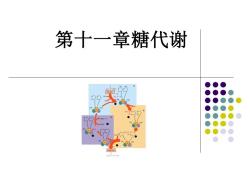
第十一章糖代谢
第十一章糖代谢
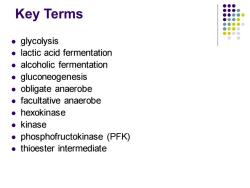
Key Terms ·glycolysis lactic acid fermentation alcoholic fermentation ●gluconeogenesis ●obligate anaerobe facultative anaerobe ●hexokinase ●kinase phosphofructokinase (PFK) thioester intermediate
Key Terms ⚫ glycolysis ⚫ lactic acid fermentation ⚫ alcoholic fermentation ⚫ gluconeogenesis ⚫ obligate anaerobe ⚫ facultative anaerobe ⚫ hexokinase ⚫ kinase ⚫ phosphofructokinase (PFK) ⚫ thioester intermediate
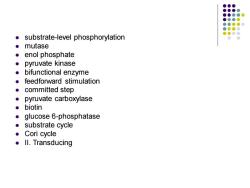
substrate-level phosphorylation ●nutase ●enol phosphate ●pyruvate kinase bifunctional enzyme feedforward stimulation ● committed step pyruvate carboxylase biotin glucose 6-phosphatase ●substrate cycle ·Cori cycle ●ll.Transducing
⚫ substrate-level phosphorylation ⚫ mutase ⚫ enol phosphate ⚫ pyruvate kinase ⚫ bifunctional enzyme ⚫ feedforward stimulation ⚫ committed step ⚫ pyruvate carboxylase ⚫ biotin ⚫ glucose 6-phosphatase ⚫ substrate cycle ⚫ Cori cycle ⚫ II. Transducing
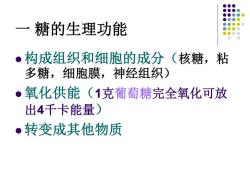
一 糖的生理功能 ·构成组织和细胞的成分(核糖,粘 多糖,细胞膜,神经组织) ·氧化供能 (1克葡萄糖完全氧化可放 出4千卡能量) 。转变成其他物质
一 糖的生理功能 ⚫构成组织和细胞的成分(核糖,粘 多糖,细胞膜,神经组织) ⚫氧化供能(1克葡萄糖完全氧化可放 出4千卡能量) ⚫转变成其他物质
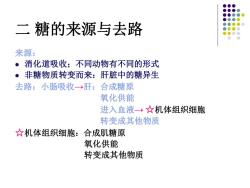
二糖的来源与去路 来源: ·消化道吸收;不同动物有不同的形式 。 非糖物质转变而来:肝脏中的糖异生 去路:小肠吸收→肝:合成糖原 氧化供能 进入血液→☆机体组织细胞 转变成其他物质 ☆机体组织细胞:合成肌糖原 氧化供能 转变成其他物质
二 糖的来源与去路 来源: ⚫ 消化道吸收;不同动物有不同的形式 ⚫ 非糖物质转变而来:肝脏中的糖异生 去路:小肠吸收→肝:合成糖原 氧化供能 进入血液→ ☆机体组织细胞 转变成其他物质 ☆机体组织细胞:合成肌糖原 氧化供能 转变成其他物质
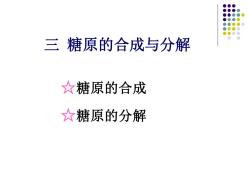
三糖原的合成与分解 ☆糖原的合成 ☆糖原的分解
三 糖原的合成与分解 ☆糖原的合成 ☆糖原的分解
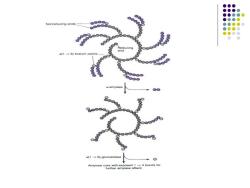
Nonreducing ends -.6)branc a1→6)-glucosidas Amylose core with exposed 1-4 bonds for further amylase attack
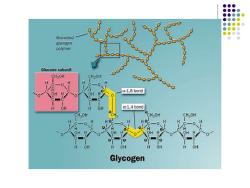
Branched glycogen polymer Glucose subunit CH2OH H Qo.O a-1,6 bond OH OH o-1,4 bond CH2OH H H 2 OH OH OH Glycogen
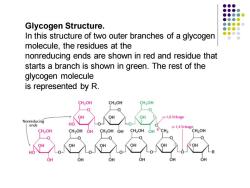
Glycogen Structure. In this structure of two outer branches of a glycogen molecule,the residues at the nonreducing ends are shown in red and residue that starts a branch is shown in green.The rest of the glycogen molecule is represented by R. CH2OH CH2OH CH2OH 0 0 OH OH OH c-1,6 linkage Nonreducing ends HO CH2OH CH2OH OH CH2OH OH CH2OH OH 6 CH2 1 linkagCH2OH 0 OH HO
Glycogen Structure. In this structure of two outer branches of a glycogen molecule, the residues at the nonreducing ends are shown in red and residue that starts a branch is shown in green. The rest of the glycogen molecule is represented by R
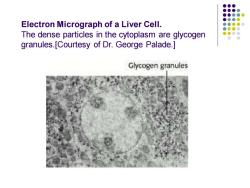
Electron Micrograph of a Liver Cell. The dense particles in the cytoplasm are glycogen granules.[Courtesy of Dr.George Palade.] Glycogen granules
Electron Micrograph of a Liver Cell. The dense particles in the cytoplasm are glycogen granules.[Courtesy of Dr. George Palade.]
按次数下载不扣除下载券;
注册用户24小时内重复下载只扣除一次;
顺序:VIP每日次数-->可用次数-->下载券;
- 《生物化学》课程教学课件(PPT讲稿)第十章 生物能学与生物氧化(Bioenergetics and Biological Oxidation)第四节 氧化磷酸化作用 oxidation phosphorylation 2/2.ppt
- 《生物化学》课程教学课件(PPT讲稿)第十章 生物能学与生物氧化(Bioenergetics and Biological Oxidation)第三节 线粒体电子传递链 electron-transport chain 1/3.ppt
- 《生物化学》课程教学课件(PPT讲稿)第十章 生物能学与生物氧化(Bioenergetics and Biological Oxidation)第四节 氧化磷酸化作用 oxidation phosphorylation 1/2.ppt
- 《生物化学》课程教学课件(PPT讲稿)第十章 生物能学与生物氧化(Bioenergetics and Biological Oxidation)第三节 线粒体电子传递链 electron-transport chain 3/3.ppt
- 《生物化学》课程教学课件(PPT讲稿)第十章 生物能学与生物氧化(Bioenergetics and Biological Oxidation)第三节 线粒体电子传递链 electron-transport chain 2/3.ppt
- 《生物化学》课程教学课件(PPT讲稿)第十章 生物能学与生物氧化(Bioenergetics and Biological Oxidation)第一节 自由能 第二节 高能磷酸化合物.ppt
- 《生物化学》课程教学课件(PPT讲稿)第九章 脂类与生物膜 第三节 生物膜的功能 4/5.ppt
- 《生物化学》课程教学课件(PPT讲稿)第九章 脂类与生物膜 第三节 生物膜的功能 3/5.ppt
- 《生物化学》课程教学课件(PPT讲稿)第九章 脂类与生物膜 第三节 生物膜的功能 5/5.ppt
- 《生物化学》课程教学课件(PPT讲稿)第九章 脂类与生物膜 第三节 生物膜的功能 2/5.ppt
- 《生物化学》课程教学课件(PPT讲稿)第九章 脂类与生物膜 第三节 生物膜的功能 1/5.ppt
- 《生物化学》课程教学课件(PPT讲稿)第九章 脂类与生物膜 第二节第二节 生物膜结构 3/3.ppt
- 《生物化学》课程教学课件(PPT讲稿)第九章 脂类与生物膜 第二节第二节 生物膜结构 2/3.ppt
- 《生物化学》课程教学课件(PPT讲稿)第九章 脂类与生物膜 第二节第二节 生物膜结构 1/3.ppt
- 《生物化学》课程教学课件(PPT讲稿)第八章 核酸(nucleic acid)第六节 核酸的分离与鉴定.ppt
- 《生物化学》课程教学课件(PPT讲稿)第八章 核酸(nucleic acid)第四节 RNA的结构.ppt
- 《生物化学》课程教学课件(PPT讲稿)第八章 核酸(nucleic acid)第五节 核酸的性质.ppt
- 《生物化学》课程教学课件(PPT讲稿)第八章 核酸(nucleic acid)第三节 DNA的结构 2/4.ppt
- 《生物化学》课程教学课件(PPT讲稿)第八章 核酸(nucleic acid)第三节 DNA的结构 4/4.ppt
- 《生物化学》课程教学课件(PPT讲稿)第八章 核酸(nucleic acid)第三节 DNA的结构 3/4.ppt
- 《生物化学》课程教学课件(PPT讲稿)第十二章 脂类代谢.ppt
- 《生物化学》课程教学课件(PPT讲稿)第十三章 蛋白质代谢.ppt
- 《生物化学》课程教学课件(PPT讲稿)第十四章 核苷酸的代谢.ppt
- 《生物化学》课程教学课件(PPT讲稿)第十五章 代谢整合.ppt
- 《生物化学》课程教学课件(PPT讲稿)第十七章 RNA的生物合成.ppt
- 《生物化学》课程教学课件(PPT讲稿)第十九章 基因工程简介.ppt
- 《普通遗传学》课程教学大纲(中国农业大学:刘庆昌).pdf
- 《普通遗传学》课程教学资源(试卷习题,无答案)试卷9.doc
- 《普通遗传学》课程教学资源(试卷习题,无答案)试卷7.doc
- 《普通遗传学》课程教学资源(试卷习题,无答案)试卷8.doc
- 《普通遗传学》课程教学资源(试卷习题,无答案)试卷6.doc
- 《普通遗传学》课程教学资源(试卷习题,无答案)试卷5.doc
- 《普通遗传学》课程教学资源(试卷习题,无答案)试卷2.doc
- 《普通遗传学》课程教学资源(试卷习题,无答案)试卷3.doc
- 《普通遗传学》课程教学资源(试卷习题,无答案)试卷4.doc
- 《普通遗传学》课程教学资源(试卷习题,无答案)试卷1.doc
- 《普通遗传学》课程教学资源(试卷习题,无答案)试卷18.doc
- 《普通遗传学》课程教学资源(试卷习题,无答案)试卷19.doc
- 《普通遗传学》课程教学资源(试卷习题,无答案)试卷17.doc
- 《普通遗传学》课程教学资源(试卷习题,无答案)试卷20.doc
